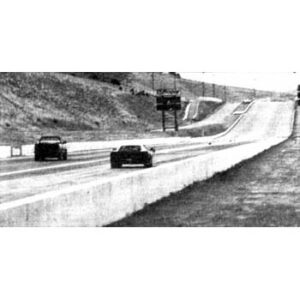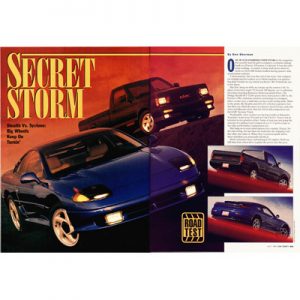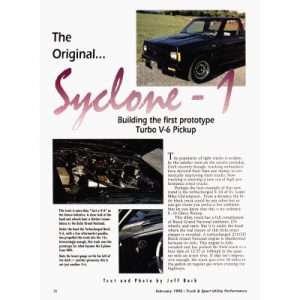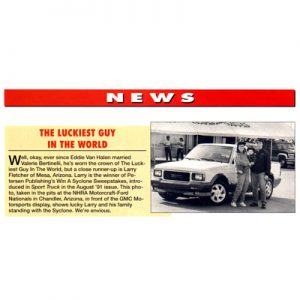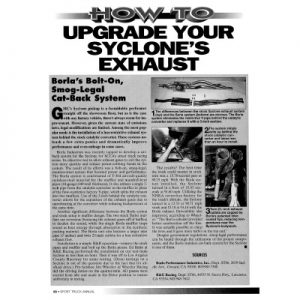Sport Truck
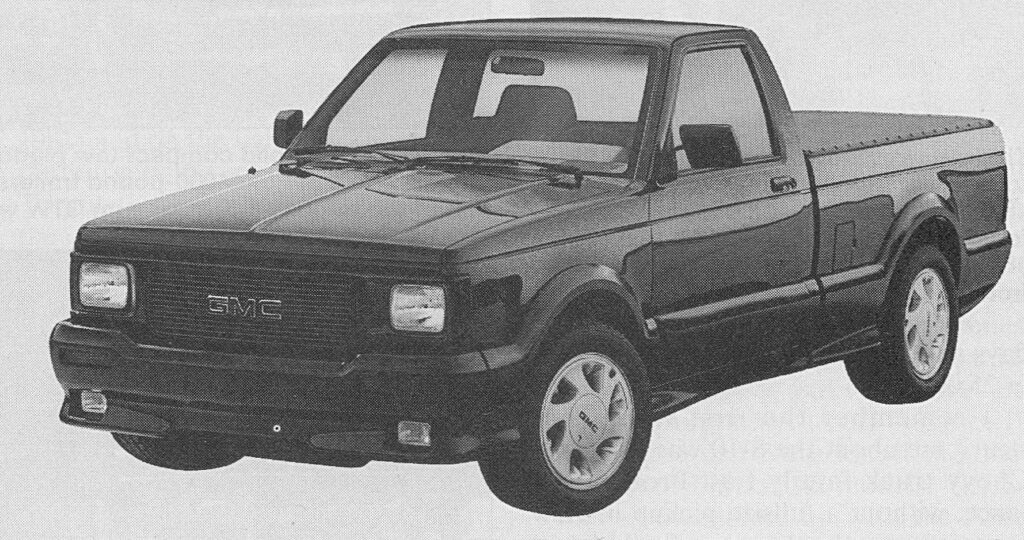
By Todd Kaho
Twelve years ago on a warm July morning, I found myself standing on the blacktop at GM’s Milford proving grounds. There was electricity in the air, Chevy was unveiling its long-awaited domestically produced compact pickup to the media. In those days, we called them “mini-trucks” and I was on-hand to cover the landmark event as technical editor of Mini-Truck magazine.
From a ’90s perspective, it’s easy to overlook the impact the new S-trucks and Ford Ranger (introduced in early 1982) had on the light-truck market and the burgeoning sport truck movement. To put things in perspective, consider the other small trucks we had to choose from in the early ’80s. Toyota, Datsun (pre-Nissan), Isuzu, Mitsubishi, and Mazda were the major players in the mini-truck segment. Isuzu was supplying rebadged trucks to GM, which were sold as the Chevy LUV, Mazda was Ford’s connection importing the Courier, and Mitsubishi was selling D-50s and Arrows to Chrysler. On an even smaller scale, Subaru was selling the Brat, and VW was offering a Rabbit-based unibody pickup. The Dodge and Plymouth variants from Mitsubishi were the reigning performance champs powered by the “big” 2.6-liter silent shaft four.
This was an era when CAFE standards had strangled performance and O.E.M. technology hadn’t quite caught up. Most of the major import pickups offered a four-cylinder diesel. Quartermile times in the low 20-second range weren’t uncommon some diesels were painfully slow.
So when news leaked out in the late ’70s that both General Motors and Ford were engineering all new domestic small trucks, the excitement was understandable. Chevy and GMC beat Ford to the punch by a full six months, rolling the first S-trucks off the line in the fall of 1981 as ’82 models. The S-10 was an immediate hit with the American truck buyer, recording the fastest sales start in the division’s light-truck history. Even with limited availability, Chevy sold 12,000 S-10s in the first 60 days and had backlog orders for another 25,000.
I remember the first thing that struck me about the S-10 was its strong Chevy truck family ties. From a distance, without a fullsize pickup in view for reference, the then-new S-10 looked very much like a C-10. But the S-10 was radically different from anything else offered at the time because it could be ordered in so many different configurations.
You could buy an S-10 in either a shortbed (72.8 inches) or longbed (88.8 inches), four different trim levels, two engines, three transmissions, and two optional payload packages. The base S- 10 was the economy model, followed by the Durango midlevel, the Tahoe luxury package, and the Sport, which drew a lot of interest from enthusiasts. All four trim levels were well packaged, with unique touches to set them apart from their siblings. The Sport even had a repeating “truck” design stitched into the seat fabric and door panel inserts.
Base engine for the first S-10 model was a 1.9-liter four-cylinder rated at 82 horsepower at 4300 rpm and 95 lb-ft of torque at 3000 rpm. The four could be mated with your choice of four-speed manual, five-speed manual, or three-speed automatic. EPA figures were much more optimistic in those days, and the 1.9 with a four-speed rated 28 mpg city and 39 mpg highway, 28 mpg and 40 mpg on the California version. In the real world, you could count on mid-20-mpg numbers.
The big news for sport truck enthusiasts was the availability of a V6 engine. This was the first offering of anything other than a four banger in the mini-truck segment. The carbureted 2.8-liter 60-degree V6 derived from the transverse-mounted engine used in the X-Car line seemed like a powerhouse at the time. By today’s standards, it was anemic, but in 1981, a rating of 110 horsepower at 4800 rpm and 145 lb-ft of torque at 2400 rpm made big news. The V6 eclipsed the Mitsubishi MCA Jet Silent Shaft four by 5 horsepower and 6 lb-ft of torque. But the real difference was the way it felt. In comparison to the fours, the V6 felt like a real truck engine and it had tons of hot rod potential. At introduction time, Chevy didn’t have a five-speed manual that would work with the V6, but one was promised by the end of the ’82 model year. You had a choice of either a fourspeed manual or a three-speed automatic.
I remember my first brief test drive in a bright red S-10 Sport that warm day in July of 1981. I headed out of the staging area on the proving ground’s “truck loop” and waited until well out of sight and ear shot before standing on the gas. My neck didn’t exactly snap, but compared to the import trucks of the day, the V6-powered S-10 felt like a muscletruck. The resulting feature story graced the October 1981 issue of Mini Truck with a shot of the same red S-10 Sport cooking around a gravel right hander with the blurb. “American Muscle In A Small Pickup.” Chevy cranked out 152,880 S-lOs in the ’82 model year.
The second full year of the S-truck brought major additions an extended-cab model, compact Blazer, and the introduction of four-wheel drive across the board. Chevrolet General Manager Robert Stemple called 1983 “Phase II in the evolution of the most comprehensive compact truck lineup in the industry.”
The base 1.9-liter four was replaced by a new 2.0-liter. The carbureted four was derived from the high-torque engine that powered the Cavalier passenger car. The 2.0 was smoother than the 1.9, offered more low-end punch and 83 horsepower. You could now get a five-speed manual with the 2.8 V6.
The extended cab was an immediate hit with taller drivers and truckers who needed to carry a moderate amount of cargo securely inside the cab. Two small jump seats folded out of the side of the rear compartment. The seat design hasn’t changed over the years and is best suited for small kids. Average-size adults can squeeze in for short hops, but anything longer can make for an uncomfortable ride. Even if you never use the rear seats, the additional 14.5 inches of interior room adds greatly to comfort and convenience.
The little Blazer was also an instant success story. One of the sparks that made the compact sport/utility segment so hot, the Blazer was initially offered in three trim levels. The new 2.0-liter four was the standard engine, but most buyers opted for the more powerful V6.
The S-truck’s new four-wheel-drive system offered a torsion-bar independent front suspension. Chevy’s IFS design utilizes conventional upper and lower control arms, with the torsion bars attached to the lower control arm. The front axle has a center disconnect that allows shifting in or out of 4WD in high range on the fly. The transfer-case lever on the cab floor activates a vacuum diaphragm that locks and unlocks the center front disconnect rather than using auto-locking front hubs. This system became known as Insta-Trac and is currently used on fullsize Chevy trucks as well.
As if these major changes weren’t enough, ’83 also brought a new four-cylinder diesel late in the model year. Though not a popular option with the sport truck crowd (or any other crowd for that matter), the 2.2-liter naturally aspirated diesel promised 62 horsepower, 96 lb-ft of torque and EPA’s optimistic 43-mpg highway mileage. S-10 production in ’83 rose to 181,162 units.
The next year brought only minor changes to the S-10 line. Big news in ’84 was new suspension packages that included Bilstein gas shocks. Two-wheel-drive models were modified with softer rate front springs. Though ’84 didn’t seem like a major year in S-10 development, this was the year Chevy got serious about sport truck handling. The S-10 was offered with a special ZQ8 sport suspension option that included performance rubber, a quick-ratio steering gear, heavier stabilizer bar, and Bilstein gas shocks. For those who found out about it, the ZQ8 package worked wonders making the S-10 Sport one of the best handling pickups on the road. Other mechanical changes in ’84 included retuned torque converters for automatics and a new hydraulic clutch in manual tranny S-10s. Chevy dealers saw 185,726 S-10s leave their lots in ’84.
The engine line changed in ’85 to include a larger 2.5-liter throttle-body four-cylinder, bringing a good balance of performance and economy. Automatic-equipped S-trucks were fitted with a Fourth overdrive gear. Corrosion resistance was improved with the addition of more two-sided galvanized sheetmetal in the front of all S-trucks. S-10 sales broke the 200,000 mark in ’85, with the final production number settling on 203,324.
By ’86, the S-10 was facing increased competition on a variety of fronts. GM countered by adding electronic throttlebody fuel injection to the 2.8-liter V6. TBI improved performance, fuel economy, and overall drivability. Chevy rated the TBI 2.8 at 125 horsepower at 4800 rpm; a nine-percent increase. Torque also improved, earning a 150 lb-ft rating at 2400 rpm. The 2.5-liter four saw internal revisions with new pistons and exhaust valve seat geometry. Chevy also introduced its new “high-tech” electronic instrument panel. Enthusiasts preferred the older analog design. S-10 sales grew again, with Chevy moving 215,201 trucks by the year’s end.
In ’87, Chevy continued development of the 2.5-liter four, changing to high-flow ports in the cylinder head and a redesigned intake manifold. Horsepower increased seven percent to 92 hp at 4400 rpm. S-truck engines were altered to accept a single serpentine belt in place of multiple V-belts. Chevy also introduced a new” three-speed automatic transmission as an economical alternative to the more expensive fourspeed OD automatic. S-10 sales in ’87 totaled 216,693 units.
While ’88 seemed like a carry-over year for the S-10 line, rumors were circulating that S-trucks would soon receive the large-displacement 4.3-liter Vortec V6 Chevy was selling in the Astro van. By the end of the year, the 4.3 became a reality with 1989 becoming the first full year for 4.3 availability in the S-10. Enthusiasts’ wishes came true when Chevy introduced the 4.3-liter V6 along with two limited-edition trucks midyear in ’88. The Serengeti Blazer offered high-line amenities for sport/utility buyers. Street truck fans were treated to a sporty Cameo. With a lower front fascia that incorporated driving lights, side ground-effects skirts, a roll rear pan, monochromatic paint, and the 4.3-liter six under the hood, the Cameo was a sport truck dream come true.
The throttle body EFI 4.3 produced 160 horsepower at 4000 rpm and a tire-shredding 230 lb-ft of torque at 2800 rpm in ’88 trim. Unfortunately, the only transmission initially offered was an automatic. Other minor changes in ’88 included the addition of a factory installed sunroof and instrument panel color revision for a more contemporary look. A total of 235,452 S-10s were sold in ’88.
Availability of the 4.3 V6 improved in ’89 and was being ordered in one of every five S-10s built. The big news mechanically in ’89 was the addition of rear-wheel antilock brakes across the board. Fancier S-10s could be ordered with a new digital electronic vacuum fluorescent instrument panel. The Insta-Trac four-wheel-drive transfer case was also revised in ’89 for quieter, smoother operation. The limited-edition Cameo sport truck was continued in ’89 in a choice ‘of red, white, or black. S- 10 sales reached an all-time high in 1989, with sales totaling 241,866 trucks.
The S-truck entered a new decade with only minor changes. The best news for performance enthusiasts in ’90 was the addition of a new fivespeed manual for the 4.3-liter V6. The Getrag-designed transmission offered improved performance in both street and off-road applications. The 2.5-liter four was updated with several minor mechanical changes and an EL base-model value package was offered. Blazers were now shipped with the 4.3 V6 as standard equipment. A four-door version of the Blazer was also introduced. Sales dropped in ’90 with the year-end total coming to 210,773 S-10s.
In ’91, the 2.5-liter L38 was replaced with the 2.5 LN8, which became the standard powerplant on all two-wheel-drive S-10s. Major changes included a new intake, cylinder head, cam profile, crank bearings, air-induction system, exhaust system, and Quantum spark plugs. The modifications added up to a power increase from 94 hp at 4400 rpm to 105 hp at 4800 rpm. A new 220 series TBI unit was introduced on the 4.3 V6 to improve starting and idling. Suspension systems were revised with new spring rates, revalved shocks, and a change in front stabilizer bars. Chevy closed out the ’91 model year by selling 206,893 S-10s.
GMC division made ’91 a milestone year in compact truck performance with the introduction of the Syclone. With 0 to 60 times under five seconds, the turbocharged Vortec V6 terror was competition for the ZR-1 Corvette. The intercooled turbo port-injected Vortec pumps out an incredible 285 hp at 4400 rpm and 350 lb-ft of torque at 3600 rpm. Syclone put power to the ground through a fulltime all-wheel-drive system and offered the security of four-wheel ABS. While only offered for two years, Syclone became the pinnacle of S-truck performance and is still the sport truck by which all others are measured. The Syclone is succeeded by the Jimmy-based Typhoon super sport! utility.
The S-10 turned 10 years old showing its age. Chevy made a host of minor changes in ’92, with the most significant change being a High Performance version of the 4.3-liter Vortec V6. A central port electronic fuel-injection system offered noticeable performance gains and an internal gear-driven balance shaft helped smooth out the big six. The engine produces an honest 200 horsepower at 4500 rpm and 260 lb-ft of torque at 3600 rpms. Other changes in ’92 included introduction of a 4×4 EL, optional electronic push-button transfer case operation, and interior head restraint on all models. Chevy sold a total of 186,882 S-10s last year.
The current model-year truck looks about the same except for the addition of a new grille treatment. Mechanical improvements include the internal balance shaft added to all 4.3 engines and the addition of the 4L60-E electronic automatic offered with the 4.3 V6. The new “smart” automatic provides improved performance and variable shift points that adapt to the driving demands at hand. The ’93 interior features a new 60/40 bench, and improved center console on bucket seat-equipped models.
But most people won’t remember much about ’93 S-trucks an all-new second-generation S-truck will debut in ’94. Looking back at the last 12 years, it’s easy to see what an impact the S-10 has had on the sport truck market. The new truck has big shoes to fill.
The pinnacle of S-truck performance came when GMC unleashed the Syclone on the world. With a intercooled turbocharged 285hp 4.3 V6 under the hood, all-wheel-drive, four-wheel ABS, and sub-five-second 0 to 60 times, it was a Corvette owner’s worst nightmare.

